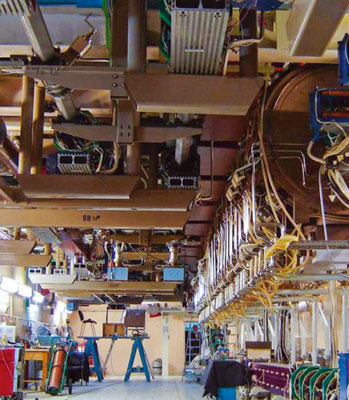
Over the past 30 years, the Budker Institute of Nuclear Physics in Novosibirsk has developed many free-electron lasers (FELs). The most recent one, which has been in operation since 2003, is a continuous-wave terahertz FEL based on a single-orbit energy-recovery linac (ERL), which is the world’s most intense radiation source at terahertz wavelengths. The laboratory is now making progress in constructing a four-orbit 40 MeV electron ERL to generate radiation in the range 5–250 μm. Already operating with two orbits, this is the world’s first multiturn ERL.
FELs provide coherent radiation in the wavelength range from 0.14 nm to 1 mm. They use the phenomenon of stimulated radiation from relativistic electrons moving in an undulator – a special magnet that creates a periodic alternating field such that the electron trajectory remains close to a straight line (the undulator axis). Travelling through an undulator, electrons amplify a collinear electromagnetic wave if the last one has wavelength λ = d/(2γ2), where d is the undulator period, and γ is the particle’s total energy divided by its mass.
Unfortunately, the maximum electron efficiency of FELs is only about 1%, which makes energy recovery a desirable feature. The simplest realization of energy recovery for an FEL is to install it into a straight section of a storage ring. Such storage-ring FEL facilities exist now but the power of their radiation does not exceed a few watts. The intrinsic limitation of the power is caused by multiple interactions of the same electrons with light, which increases the energy spread of the beam. To achieve high light power, it is better to use a fresh beam, which is just what ERLs can do.

The Novosibirsk ERL has a rather complicated magnetic system, which makes use of a common accelerating structure (figure 1). This differs from other ERL-based FEL facilities in that it uses low-frequency (180 MHz) non-superconducting RF cavities, with continuous-wave operation. The existing terahertz FEL uses one orbit, which lies in the vertical plane. This FEL generates coherent radiation, tunable in the range 120–240 μm. It produces a continuous train of 40–100 ps pulses at a repetition rate of 5.6–22.5 MHz. The maximum average output power is 500 W, with a peak power of more than 1 MW. The minimum measured linewidth is 0.3%, which is close to the Fourier-transform limit. A beamline directs the radiation from the FEL in the accelerator hall to the user hall. It is filled with dry nitrogen and separated from the accelerator vacuum by a diamond window, and from the air by polyethylene windows. Radiation is delivered to six stations, two of which are used for the measurement of radiation parameters, and the other four by users, typically biologists, chemists and physicists.
The other four orbits of the final ERL lie in the horizontal plane. The beam is directed to these orbits by switching on two round magnets. The electrons will pass through the RF cavities four times, to reach 40 MeV. After the fourth orbit the beam will be used in an FEL, before being decelerated four times. A bypass with another FEL is installed at the second orbit (20 MeV). When the bypass magnets are switched on, the beam passes through this FEL. The length of the bypass has been chosen to provide the delay necessary in this case to give deceleration on the third pass through the accelerating cavities.
Two of the four horizontal orbits were assembled and commissioned in 2008. The electron beam was accelerated twice and then decelerated down to the low injection energy, thus successfully demonstrating the world’s first multiorbit ERL operation. The first lasing of the FEL at the bypass was achieved in 2009, providing radiation in the wavelength range 40–80 μm. At first a significant (several per cent) increase in beam loss occurred during lasing. Sextupole correctors were therefore installed in some of quadrupoles to make the 180° bends achromatic to second order. This increased the energy acceptance for the reused electron beam. The output power is about 0.5 kW at an ERL average current of 9 mA. The output of this new FEL is near 70 μm, so the power obtained is also the world record for this wavelength range.
The beamline to deliver radiation from the new FEL to existing user stations has been assembled and commissioned. Thus, the world’s first two-orbit ERL is now operating for a far infrared FEL. In the meantime, the assembly of the third and fourth ERL orbits is in progress.








